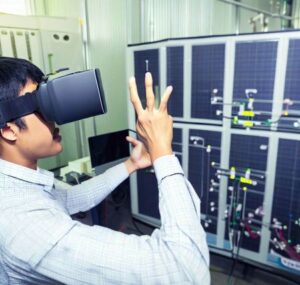Haptic solutions, which involve the use of tactile feedback and sensations, can play a significant role in enhancing the design and decision-making processes for solar PV plants, including PV module selection. Here’s how haptic solutions can contribute:
1. Virtual Reality (VR) and Haptic Feedback:
By integrating haptic feedback into virtual reality simulations, designers and engineers can physically feel and interact with different module options, layouts, and configurations. This immersive experience provides a tangible sense of how various modules might perform in different scenarios, aiding in better decision-making.
2. Tactile Module Comparison:
Haptic interfaces can simulate the texture, weight, and other physical characteristics of PV modules virtually. Designers can virtually „handle” different modules, mimicking real-world experiences. This tactile comparison can help in assessing module quality and durability.
3. Sensitivity to Shading and Layouts:
Haptic simulations can provide designers with a tactile understanding of how shading impacts module performance. Designers can physically „feel” the changes in shading patterns as they manipulate virtual module layouts, aiding in optimal placement and orientation decisions.
4. Real-Time Feedback on Efficiency:
Haptic solutions can provide real-time feedback on efficiency changes as different modules are adjusted. Designers can feel the difference in energy production as they modify parameters, helping them identify the most productive module configurations.
5. Collaboration and Communication:
Haptic simulations enable collaborative decision-making. Design teams can gather in a virtual space, „touch” modules, and discuss choices in real time. This enhances communication and alignment among team members.
6. Enhanced Training and Familiarization:
Haptic simulations can serve as training tools for solar professionals. Engineers, installers, and maintenance teams can practice module handling, installation, and maintenance procedures in a virtual environment.
7. Accessibility for Non-Experts:
Haptic interfaces can simplify complex concepts for non-experts. Investors, stakeholders, and decision-makers who may not be familiar with solar technology can grasp key concepts through tactile interaction.
8. Impact on Aesthetic Considerations:
Haptic feedback can simulate the appearance and texture of modules, aiding in evaluating their aesthetic fit within the project’s context. This is particularly valuable for projects where visual integration matters.
9. Iterative Design Process:
Haptic simulations facilitate rapid and iterative design processes. Designers can quickly test and modify module selections, placements, and configurations in a tactile manner, leading to more refined outcomes.
10. Human-Centric Design:
Haptic solutions prioritize human senses in the design process. By incorporating touch and tactile feedback, designers can create more user-centric and functional PV layouts that align with real-world conditions.
„The future of solar design lies not just in what we see, but in what we touch and feel.” – said Mr. Daniel CHIRTES, CEO of Haptic R&D Consulting SRL.
Integrating haptic solutions into the solar PV plant design process enhances the decision-making process, accelerates design iterations, and offers a holistic understanding of the interactions between modules, layouts, and environmental factors. As haptic technology advances, it has the potential to revolutionize the way designers, engineers, and stakeholders interact with solar energy systems, leading to more informed and optimized design choices.